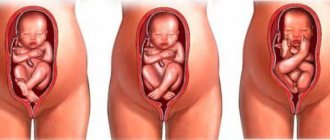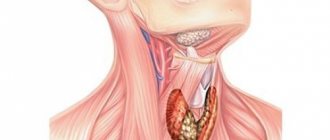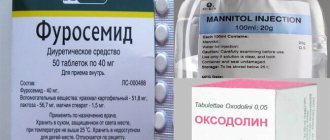Kinds
According to the timing, preterm birth is divided into very early (22-27 weeks), early (28-33 weeks) and premature (34-37 weeks). They can also be divided into incipient and threatening. Once labor has begun, it can no longer be stopped, while threatening labor can be stopped and postponed for as long as possible.
Definition and features of flow
Premature birth is characterized by a number of anomalies that can lead to serious complications. One of the main features is their rapid course - labor progresses at an accelerated pace and labor takes a shorter period of time than usual. For a fetus weighing about a kilogram, incomplete dilatation of the cervix will suffice, unlike a full-term baby. Added to this is increased activity of the uterus - contractions are approximately twice as frequent as normal.
Clinical signs
How does labor begin? The onset of labor is indicated by nagging pain in the lower abdomen and lower back, copious discharge, sometimes mixed with blood, and a toned uterus (hard belly). At this stage you can still stop the process.
The very beginning of premature labor is indicated by increased pain, contractions (up to 4 in 10 minutes), rupture of amniotic fluid and dilatation of the cervix by more than 3 cm.
Deadlines
The medical community divides such births into four categories:
- until the 28th week. These infants have the highest mortality rate. Body weight is too low - from 0.5 to 1 kg, the lungs are not yet formed.
- 28–31 weeks. Body weight reaches 1.5 kg. The lungs are also not formed, but the chance of survival with proper care is higher than that of the first group.
- 31–33 weeks. Average survival rate with mechanical ventilation.
- 34–37 weeks. This group has the highest survival rate, since in terms of body weight and degree of lung development, infants are as close as possible to full-term ones.
Content
- 1 Definition
- 2 Classification 2.1 Downstream 2.1.1 Spontaneous (70-80%)
- 2.1.2 Provoked artificially for medical reasons (20-30%)
- 4.1 Maternal factors
- 6.1 Differential diagnosis
- 12.1 Clinical manifestations of PROM
- 13.1 Primary prevention
Treatment
Patients at risk of premature birth need to especially carefully monitor their health. In many cases, it is better to agree to hospitalization to increase the chance of saving the pregnancy. Typically, the period of inpatient treatment is at least 2 weeks and consists of 4 components:
- reduction of contractile activity of the uterus with the help of special drugs: salbutamol, ginipral and others.
- prevention of fetal respiratory distress syndrome - a defect in the development of the lungs in which the child cannot breathe without assistance. Consists of taking corticosteroids to promote accelerated lung development. Usually one course of 2–4 injections is prescribed, but if the threat persists, it can be repeated after 2–3 weeks.
- sedative therapy and pain relief. Valerian is usually used as an antidepressant. For pain relief, analgesics (analgin, ketorol) and antispasmodics (baralgin, drotaverine) are prescribed.
- prevention of infectious diseases. To do this you need to take a course of antibiotics.
When labor begins, the main task is to postpone it for at least 2 days in order to have time to carry out a course of treatment with corticosteroids. The onset of labor requires an individual decision; in each case, only a doctor can choose the appropriate tactics of action.
Predictions for a child
If preterm labor is not stopped with medical intervention, the baby will be born premature. The sooner this happens, the greater the risk to the baby's health. Most premature babies require special care in the neonatal intensive care unit.
Children born prematurely have the following symptoms:
- absence or small amount of subcutaneous fat;
- a large amount of lubricant and fluff on the body;
- absence or very short hair on the head;
- softened cartilage on the nose and ears;
- the umbilical ring is lower than usual;
- nails do not reach the ends of the fingers;
- not descended testicles into the scrotum in boys;
- in girls, the labia majora have not reached sufficient size;
- weak crying in the child;
- thermoregulation is impaired, etc.
Causes
Doctors distinguish two classes of reasons:
1. Obstetric and gynecological factors - female diseases, dysfunction of the reproductive system and complications of pregnancy:
- sexual infections that lead to loss of elasticity of the uterus, due to which it cannot adapt to the size of the growing fetus;
- abnormalities of development and anatomy of the uterus;
- isthmicocervical insufficiency - inability to keep the fetus in the uterus;
- excessive distension of the uterus (large fetus, polyhydramnios, multiple pregnancy);
- pathology of the placenta;
- a history of interrupted pregnancies;
- small gap between pregnancies (< 2 years);
- child development defects;
- erythroblastosis against the background of Rh conflict in mother and child;
- threat of miscarriage at the beginning of pregnancy;
- in vitro fertilization.
- Extragenetic pathology is diseases of various organs that negatively affect the course of pregnancy:
- endocrinological diseases;
- acute infectious and inflammatory diseases (tonsillitis, ARVI, etc.);
- kidney diseases;
- heart and vascular diseases;
- surgery during pregnancy;
- woman's age is under 17 or over 35 years.
Symptoms
1) nagging, cramping pain; 2) frequent urination; 3) urge to defecate; 4) a feeling of pressure in the lower abdomen; 5) liquid discharge (when membranes rupture).
For every hundred births, there are 5–10 premature births. The highest rates are in India, China, and Pakistan. In the USA - 10.1%, the figures are high in European countries. In Russia - 4.3%. Of this number, 5-7% occurs at 22 - 27 weeks, survival in this group is no more than 20%, 30% at 28 - 32 weeks with a survival rate of 60%, the remaining babies are born at 33 - 37 weeks. According to general WHO statistics, in countries with prosperous economies, infant mortality during childbirth is 10%.
Notes
- Handbook of a practicing physician. - EKSMO, 2007. - 527 p.
- ↑ 123
WHO - RECOMMENDED DEFINITIONS, TERMINOLOGY AND FORMAT FOR STATISTICAL TABLES RELATED TO PERINATAL PERIOD AND USE OF A NEW CERTIFICATE FOR CAUSE OF PERINATAL DEATHS // Acta Obstet. Gynecol. Scand. - 1977. - T. 56, No. 3. - P. 247-253. — ISSN 0001-6349. - Tucker JM, Goldenberg RL, Davis RO et al.
Etiologies of preterm birth in an indigenous population: is prevention a logical expectation? // Obstet. and Gynecol. - 1991. - T. 77, No. 3. - P. 343-347. - PMID 1992395. - ↑ 1 2 3 Mercer BM, Goldenberg RL, Moawad AH et al.
The preterm prediction study: effect of gestational age and cause of preterm birth on subsequent obstetric outcome. National Institute of Child Health and Human Development Maternal-Fetal Medicine Units Network. //Am. J. Obstet. Gynecol. - 1999. - T. 181. - P. 1216-1221. - PMID 10561648. - ↑ 1 2 Jackson RA, Gibson KA, Wu YW et al.
Perinatal outcomes in singletons following in vitro fertilization: a meta-analysis // Obstet. and Gynecol. - 2004. - T. 104, No. 2. - P. 551-563. - PMID 15292020. - ↑ 1 2 Jakobsson M., Gissler M., Sainio S. et al.
Preterm delivery after surgical treatment for cervical intraepithelial neoplasia // Obstet. and Gynecol. - 2007. - T. 109. - P. 309-313. - PMID 17267829. - ↑ 1 2 Goldenberg RL, Tamura T.
Pregnancy weight and pregnancy outcome // JAMA - 1996. - T. 275, No. 14. - P. 1127-1128. - PMID 8601934 Footnote error: Invalid tag: name "Goldenberg96" defined multiple times for different content - ↑ 1 2 Krupa FG, Faltin D., Cecatti JG et al.
Predictors of preterm birth // Int. J. Gynaecol. Obstet. - 2006. - T. 94, No. 1. - P. 5-11. - PMID 16730012. - Smith GC, Pell JP, Dobbie R.
Interpregnancy intervaland risk of preterm birth and neonatal death: retrospective cohort study // Br. Med. J. - 2003. - T. 327. - P. 313. - PMID 12907483. - Rich-Edwards JW, Grizzard TA
Psychosocial stress and neuroendocrine mechanisms in preterm delivery // Am.J. Obstet. Gynecol. - 2005. - T. 192, No. 5. - P. 30-35. - PMID 15891710. - Melamed N. et al.
Fetal gender and pregnancy outcome // J. Matern. Fetal Neonatal Med. - 2010. - T. 23, No. 4. - P. 338-344. - PMID 20222831. - Romero R., Espinoza J., Kusanovic J. et al.
The preterm parturition syndrome // Br. J. Obstet. Gynaecol. - 2006. - T. 113. - P. 17-42. - PMID 17206962. - Ancel PY, Lelong N, Papiernik E. et al.
History of induced abortion as a risk factor for preterm birth in European countries: results of the EUROPOP survey // Hum. Reprod. - 2004. - T. 19. - P. 734-740. - PMID 14998979. - Leitich H., Brumbauer M., Kaider A. et al.
Cervical length and dilation of the internal as detected by vaginal ultrasonography as markers for preterm delivery: a systematic review // Am. J. Obstet. Gynecol. - 1999. - T. 181. - P. 1465-1472. - ITHE ACTIM™ PARTUS VERSUS THE TLIIQ® SYSTEM AS RAPID RESPONSE TESTS TO AID IN DIAGNOSING PRETERM LABOR IN SYMPTOMATIC WOMEN Institute of Health Economics: Preterm Labor in Symptomatic Women: January 2008.
- Brownfoot FC, Crowther CA, Middleton P.
Different corticosteroids and regimens for accelerating fetal lung maturation for women at risk of preterm birth // Cochrane Database Syst. Rev. - 2008. - T. 8, No. 4. - P. CD006764. - PMID 18843729. - Schrag S., Gorwitz R., Fultz Butts K. et al.
Prevention of perinatal group B streptococcal disease. Revised guidelines from CDC // MMWR Recomm. Rep. - 2002. - T. 51. - P. 1-22. - Malloy MH, Onstad L., Wright E.
The effect of Cesarean delivery on birth outcome in very low birth weight infants // Obstet. and Gynecol. - 1991. - T. 77, No. 4. - P. 498-503. - PMID 2002969. - Grant A., Penn ZJ, Steer PJ
Elective or selective caesarean delivery of the small baby? A systematic review of the controlled trials // Br. J. Obstet. Gynaecol. - 1996. - T. 103, No. 12. - P. 1197-2000. - PMID 8968235. - Ventura SJ, Martin JA, Taffel SM et al.
Advance report of fi nalnatality statistics // Monthly Vital Statistics Report from the Centers For Disease Control and Prevention. - 1995. - T. 44. - P. 1-88. - Mozurkewich E.
Management of premature rupture of membranes at term: an evidence-based approach // Clin. Obstet. Gynecol. - 1999. - T. 42, No. 4. - P. 749-756. - PMID 1057269. - Heijnen E., Eijkemans F., De Klerk C. et al.
A mild treatment strategy for in vitro fertilization: a randomized non-inferiority trial // Lancet. - 2007. - T. 369. - P. 743-749. - PMID 17336650. - Min JK, Claman P, Hughes E et al.
Guidelines for the number of embryos to transfer following in vitro fertilization // J. Obstet. Gynaecol. Can. - 2006. - T. 28, No. 9. - P. 799-813. - PMID 17022921. - Czeizel AE, Dudas I., Metnecki J.
Pregnancy outcomes in a randomized controlled trial of periconceptional multivitamin supplementation. Final report // Arch.Gynecol. Obstet. - 1994. - T. 255, No. 3. - P. 131-139. - PMID 7979565. - Lumley J., Oliver S.S., Chamberlain C. et al.
Interventions for promoting smoking cessation during pregnancy // Cochrane Database Syst. Rev. - 2004. - T. 8, No. 3. - P. CD001055. - PMID 19588322. - Kramer MS, Kakuma R.
Energy and protein intake in pregnancy // Cochrane Database of Syst. Rev. - 2003. - T. 4. - P. CD000032. - PMID 14583907. - Hofmeyr GJ, Atallah AN, Duley L.
Calcium supplementation during pregnancy for preventing hypertensive disorders and related problems // Cochrane Database Syst. Rev. - 2002. - T. 1. - P. CD001059. - PMID 11869587. - Rumbold AR, Crowther CA, Haslam RR, et al.
Vitamins C and E and the risks of preeclampsia and perinatal complications // N. Engl. J. Med. - 2006. - T. 354, No. 17. - P. 1796-1806. - PMID 16641396. - Stan C., Boulvain M., Hirsbrunner-Amagbaly P., et al.
Hydration for treatment of preterm labor // Cochrane Database Syst. Rev. - 2002. - T. 2. - P. CD003096. - PMID 12076470. - Vergnes JN, Sixou M.
Preterm low birth weight and paternal periodontal status: a metaanalysis // Am. J. Obstet. Gynecol. - 2007. - T. 196. - P. 135x1-e7. - Alfirevic Z., Heath V.C., et al.
Cervical cerclage for prevention of preterm delivery in women with short cervix: randomized controlled trial // Lancet. - 2004. - T. 363, No. 9424. - P. 1849-1853. - PMID 15183621. - Berghella V., Odibo A., To MS, et al.
Cerclage for short cervix on ultrasonography; meta-analysis of trials using individual patient data // Obstet. Gynecol. - 2005. - T. 106, No. 1. - P. 181-189. - PMID 15994635. - Fonseca E.B., Celik E., Parra M., et al.
Fetal Medicine Foundation Second Trimester Screening Group. Progesterone and the risk of preterm birth among women with a short cervix // N. Engl. J. Med. - 2007. - T. 357, No. 5. - P. 462-469. - PMID 17671254. - Berghella V. Progesterone and preterm birth prevention: translating clinical trials data into clinical practice//AJOG — 2012 #5, 376—386
How to call?
Premature labor can be caused in two ways. The more common method is medication and expectant management of pregnancy.
- Waiting tactics. The patient is first prescribed estrogens for several days. They prepare the uterus for the upcoming birth. If possible, they will try to delay the birth for as long as possible. To initiate labor, medications are used that stimulate uterine contractions: oxytocin, mifegin, prostaglandins. The drugs are administered intravenously or locally (in the form of a gel). Mifepristone, which is commonly used for medical abortion, is sometimes used. Prostaglandins take a long time to act and childbirth is very painful.
- Active tactics. The surgical method is used in emergency cases. It is characterized by active tactics of labor management. As a rule, this is a small cesarean section, the introduction of saline solutions and the opening of the amniotic sac. After the saline solution is administered, the child dies and birth occurs within 24 hours. If the saline solution is not administered and the baby is born alive, an incubator is needed for further nursing.
Contraindications to watchful waiting:
- oblique or transverse presentation of the fetus with central rupture of the membranes and an open cervical canal;
- infection in the genitals;
- period from the 36th week and later.
Artificial childbirth entails many complications in the form of bleeding, inflammation of the genital organs, hormonal imbalances and often infertility. In the absence of high-quality medical support, death is possible for both mother and child.
Pathogenesis
The most common are two theories of the mechanism of development of PR.
- Progesterone levels decrease and estrogen levels increase, resulting in increased production of oxytocin, which stimulates uterine contractions.
- Decidual activation[12] has been little studied and not proven.
But in the vast majority of cases, it is not possible to accurately establish the mechanism of development of PR. In modern obstetrics, it is generally accepted that they are the result of the influence of several factors at once, and not just one, and in each case, depending on the combination of factors and their quantity, the mechanism of development of birth defects will be different [13].
Threat of premature birth
Timely detection of a threat and prescribing the correct treatment greatly increases the chances of a normal birth. Throughout her pregnancy, the expectant mother will have to be under strict medical supervision and listen carefully to her body and the body of her child. You may have to go to the hospital to maintain the pregnancy, and in difficult cases, more than once.
Possible complications
During childbirth, there may be extensive bleeding due to a placental polyp, a part of the placenta remaining in the uterus. Injuries often cause inflammation. All this can cause infertility. Due to stimulation by hormonal drugs, a woman experiences hormonal imbalance.
What are the features and why are they dangerous?
Premature birth often has an unfavorable outcome, since the body is not yet ready. But early birth is much more dangerous for the child than for the mother. Caring for premature newborns requires special equipment and expensive medications. Only a few perinatal centers can provide this, but even there there is no one hundred percent guarantee of a successful outcome.
Conservative treatment of threatened preterm birth in a hospital
In hospitals, pregnant women receive hormonal treatment, since it is hormonal disorders that become the primary cause of the threat. Increased tone is eliminated with magnesium droppers. In case of pathology of the cervical canal, surgery is performed. Some cases require bed rest, often resorting to physical therapy. When making a diagnosis early in pregnancy, the main goal for doctors will be to push back the birth as far as possible to increase the baby's chance of survival.
Prevention
How to avoid premature birth? The best prevention is pregnancy planning, during which both parents undergo a medical examination. Doctors advise which diseases should be treated before pregnancy, and which will be more effective to treat after pregnancy, and explain how to avoid what can trigger early labor. Giving up bad habits, taking vitamins, following a routine, and proper nutrition contribute to a healthy pregnancy.
After conception, you need to regularly see a gynecologist so as not to miss the threat of miscarriage.











